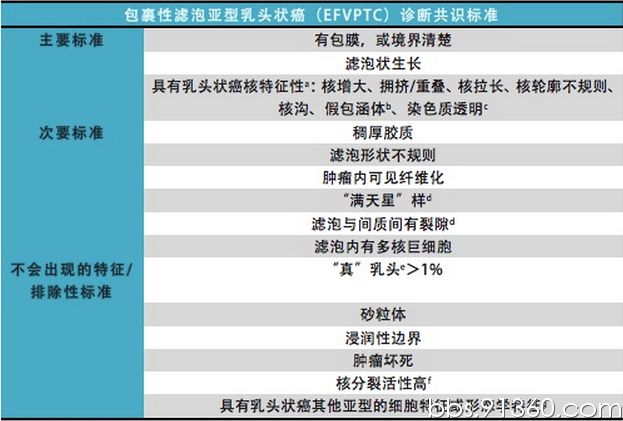|
|
登陆查看更多优秀资源帖,与同道便捷交流讨论
您需要 登录 才可以下载或查看,没有帐号?立即注册
x
原标题:一种甲状腺肿瘤的良恶性之争
作者:王强
来源:肿瘤资讯
最近,相信大部分病理医师、以及部分临床同道的朋友圈都被一篇文章刷屏了,文章的题目是《从今往后,有一种甲状腺肿瘤将不再被认定成癌症》!还有某些公众号文章直接写道《滤泡型甲状腺乳头状癌从此不再被认定成癌症》!
类似第二篇这样的,不值一驳,看完本文之后您自会判断清楚!我们今天只说第一篇,希望看完该文之后,能对各位临床及病理同仁有所帮助,同时能警醒大家对于这类非专业人士文章慎重转发!
第一篇乍一看,好像挺振奋人心的,文中亮瞎我钛合金双眼的语句层出不穷,比如“这群来自世界各地的甲状腺专家扛起了变革的大旗”、“违背首先不得伤害病人的行医准则”等等,令我莫名的惊诧,大有长此以往医将不医、国将不国之势!
但,静下心来看看,该文章错漏百出,肯定不是医学专业人士的手笔。比如,“被周围的纤维组织囊泡完全包裹起来”,其中的囊泡肯定是包膜(capsule)之误;诸如此类问题多多,尤其关键的是文中“主人公”-“带有乳头状细胞核特征的非扩散式滤泡型甲状腺肿瘤”,这个名字取的莫名其妙,不知所云!好在文中引用了其英文名称,“noninvasive follicular thyroidneoplasm with papillary-like nuclear features”,不管如何,将invasive直接理解为扩散,肯定不是专业人士所为!
面对朋友圈的“随手”转发以及表面狂喜,还是有平心静气之人的。比如笔者所在的几个微信群甲状腺病理沙龙、华夏病理-女性生殖和大病理以及肿瘤资讯微信群等就有人对此提出了不同意见,来自美国的孔祥田老师等人更是直接指出该文翻译错误。
面对铺天盖地的转发,且让我们从原文入手,逐步拨开眼前的迷雾,追寻那最终的真相吧……
原文题目是Nomenclature Revision for Encapsulated Follicular Variant of Papillary Thyroid Carcinoma: A Paradigm Shift to Reduce Overtreatment of Indolent Tumors,于2016年4月14日提前在线发表于JAMA Oncology。感兴趣的朋友可以自行查找原文。
拜读全文之后您就会发现,作者是有感于包裹性滤泡亚型乳头状癌(EFVPTC)生物学行为相对惰性、而临床治疗却大部分还是按照经典的甲状腺癌来处理,因此作者认为有必要对此进行“纠偏”。针对该问题,研究者对诊断为EFVPTC的患者进行了国际性、多中心、回顾性研究,共计109例非浸润性EFVPTC(观察了10-26年)和101例浸润性EFVPTC(观察了1-18年)。由来自7个国家和地区的24位甲状腺病理专家阅片后,根据不良后果的发生情况如死于该病、远处或局部转移、实体性或生化性复发等,制定出可区分浸润性及非浸润性EFVPTC的可靠性组织学标准。
研究中涉及的109例非浸润性EFVPTC患者(67例仅进行了腺叶切除,无一进行放射性碘治疗)在随访结束时均无病生存(中位随访时间13年,随访时间范围为10-26年)。101例浸润性EFVPTC病例中有12例(12%)出现了不良预后,其中5例出现远处转移,2例死于该病。据此,研究者提出非浸润性EFVPTC可命名为noninvasive follicular thyroidneoplasm with papillary-like nuclear features,即甲状腺伴乳头状癌核特征性的非浸润性滤泡性肿瘤(此为本人的理解,如有不妥敬请讨论。就本人所知该肿瘤的中文译文目前尚无统一性意见;也有同道翻译为具有乳头样核特征的非浸润性滤泡性甲状腺肿瘤),简写为NIFTP。
值得一提的是,文中还提出了诊断NIFTP的标准并进行了验证,结果证实该标准的敏感性为98.6%、特异性为90.1%,总体准确性为94.3%。
相信看到这里,各位看官就一目了然了:原来是把甲状腺包裹性滤泡亚型乳头状癌中那些无浸润者单独列出来,对其处理可以采取腺叶切除;而对于那些浸润性包裹性滤泡亚型乳头状癌,则还是老办法处理!举例说来:严打期间,对于小偷小摸和杀人犯的处理一致,一概发配北大荒!后来发现发配北大荒的罪犯中有些并无太大罪恶,因此重新研究、并制定标准后,将小偷小摸者筛选出来,处以拘留半月、以观后效的惩罚即可!
当然,作为最靠谱的科普文章提供者,我们肿瘤资讯肯定不会止步于此,下面就把原文中的干货奉献给大家:

![$`{D62%LSSYV~]N6{232_JH.png $`{D62%LSSYV~]N6{232_JH.png](https://a1.cdn.91360.com/bbsattachment/forum/201604/20/094425e8ivq4m8ptw95t9p.png)
![[8%6G_KX7%DK_$)ZTP6@]@6.png [8%6G_KX7%DK_$)ZTP6@]@6.png](https://a1.cdn.91360.com/bbsattachment/forum/201604/20/094433lslltccxgxwxtl3l.png)
文中配图:

(A):肿瘤大体观,具有薄包膜;
(B):肿瘤的包膜(箭头处)及微滤泡状生长模式;HE染色,N为正常甲状腺滤泡;原始放大倍数×100
![HBHOBI]2XZ8R8B8L5X2A_9H.png HBHOBI]2XZ8R8B8L5X2A_9H.png](https://a1.cdn.91360.com/bbsattachment/forum/201604/20/094454j5ii95f4995hm48m.png)
(C):主要诊断特征有核增大、拉长;最好将肿瘤细胞核的大小及形状与周围正常组织对比观察;HE染色,原始放大倍数×400;
(D):核轮廓不规则,染色质透明;HE染色,原始放大倍数×400。
---------------
附原文:
Nomenclature Revision for Encapsulated Follicular Variant of Papillary Thyroid Carcinoma:A Paradigm Shift to Reduce Overtreatment of Indolent Tumors
Importance Although growing evidence points to highly indolent behavior of encapsulated follicular variant of papillary thyroid carcinoma (EFVPTC), most patients with EFVPTC are treated as having conventional thyroid cancer.
Objective To evaluate clinical outcomes, refine diagnostic criteria, and develop a nomenclature that appropriately reflects the biological and clinical characteristics of EFVPTC.
Design, Setting, and Participants International, multidisciplinary, retrospective study of patients with thyroid nodules diagnosed as EFVPTC, including 109 patients with noninvasive EFVPTC observed for 10 to 26 years and 101 patients with invasive EFVPTC observed for 1 to 18 years. Review of digitized histologic slides collected at 13 sites in 5 countries by 24 thyroid pathologists from 7 countries. A series of teleconferences and a face-to-face conference were used to establish consensus diagnostic criteria and develop new nomenclature.
Main Outcomes and Measures Frequency of adverse outcomes, including death from disease, distant or locoregional metastases, and structural or biochemical recurrence, in patients with noninvasive and invasive EFVPTC diagnosed on the basis of a set of reproducible histopathologic criteria.
Results Consensus diagnostic criteria for EFVPTC were developed by 24 thyroid pathologists. All of the 109 patients with noninvasive EFVPTC (67 treated with only lobectomy, none received radioactive iodine ablation) were alive with no evidence of disease at final follow-up (median [range], 13 [10-26] years). An adverse event was seen in 12 of 101 (12%) of the cases of invasive EFVPTC, including 5 patients developing distant metastases, 2 of whom died of disease. Based on the outcome information for noninvasive EFVPTC, the name “noninvasive follicular thyroid neoplasm with papillary-like nuclear features” (NIFTP) was adopted. A simplified diagnostic nuclear scoring scheme was developed and validated, yielding a sensitivity of 98.6% (95% CI, 96.3%-99.4%), specificity of 90.1% (95% CI, 86.0%-93.1%), and overall classification accuracy of 94.3% (95% CI, 92.1%-96.0%) for NIFTP.
Conclusions and Relevance Thyroid tumors currently diagnosed as noninvasive EFVPTC have a very low risk of adverse outcome and should be termed NIFTP. This reclassification will affect a large population of patients worldwide and result in a significant reduction in psychological and clinical consequences associated with the diagnosis of cancer.
Introduction
The increasing incidence of cancer worldwide is multifactorial, attributable to population longevity, changing environmental and lifestyle factors, and increased surveillance. Thyroid cancer is a prime example for which intensified surveillance has resulted in an increasing incidence of early cancers with indolent behavior,1,2 a phenomenon commonly described as cancer “overdiagnosis.”3 The increasing incidence is solely attributable to papillary thyroid carcinoma (PTC), a tumor named for its papillary growth pattern, although the defining diagnostic criteria are actually the nuclear features of neoplastic cells.4 Aside from the enhanced screening, another important factor contributing to this phenomenon is the increase in diagnosis of a variant of PTC known as the follicular variant of PTC (FVPTC).5
The follicular variant of PTC was broadly recognized in the mid-1970s as a tumor composed of neoplastic follicles rather than papillae, but with follicular cells showing nuclear features characteristic of PTC.4 Two main subtypes are known to occur: infiltrative (or nonencapsulated) and encapsulated.6(pp100-109)7 Encapsulated FVPTC (EFVPTC) has increased in incidence by an estimated 2- to 3-fold over the past 2 to 3 decades and makes up 10% to 20% of all thyroid cancers currently diagnosed in Europe and North America (eTable 1 in the Supplement).5,8
Encapsulated FVPTC is a challenging and controversial diagnosis in thyroid gland pathology. In those tumors that have no invasion, the diagnosis of cancer rests exclusively on finding the characteristic nuclei, assessment of which in many cases is subjective and even contentious, leading to consistently high interobserver variability.9- 11 Furthermore, studies over the past decade have demonstrated that FVPTC overall,12 and particularly EFVPTC, has an indolent behavior and is genetically distinct from infiltrative tumors.7,13- 17 Yet, most patients with EFVPTC continue to be treated similarly to those with conventional PTC. Aside from the stigma of a “cancer” diagnosis and the morbidity of aggressive treatment for PTC, patients and health care professionals have to cope with the rapidly increasing costs of care for patients with thyroid cancer, which were estimated to exceed $1.6 billion in 2013 in the United States alone.18
Recognizing the problem of overdiagnosis and overtreatment of indolent cancers in many organs, the National Cancer Institute convened in 2012 a conference to evaluate this problem. Following the conference, a statement from a number of participants emphasized the need to revise terminology, replacing the word “cancer” when data emerge to support a more indolent designation.19 The goal of the current project was to assemble an international group of expert pathologists and clinicians to reexamine the entity currently known as EFVPTC through a review of a set of cases with long follow-up to (1) establish standardized diagnostic criteria and (2) identify terminology that would appropriately address the biological and clinical characteristics of this lesion.
|
|